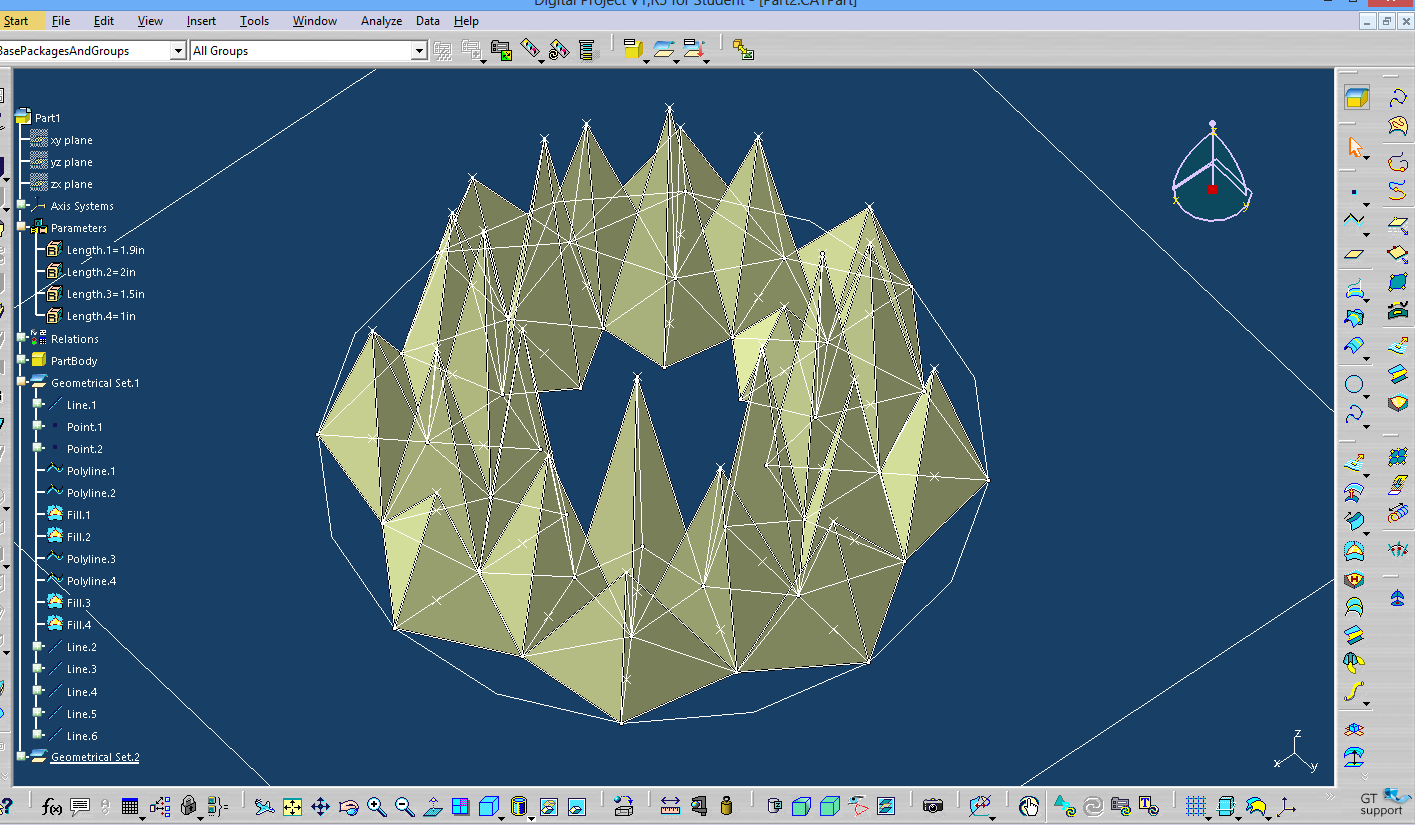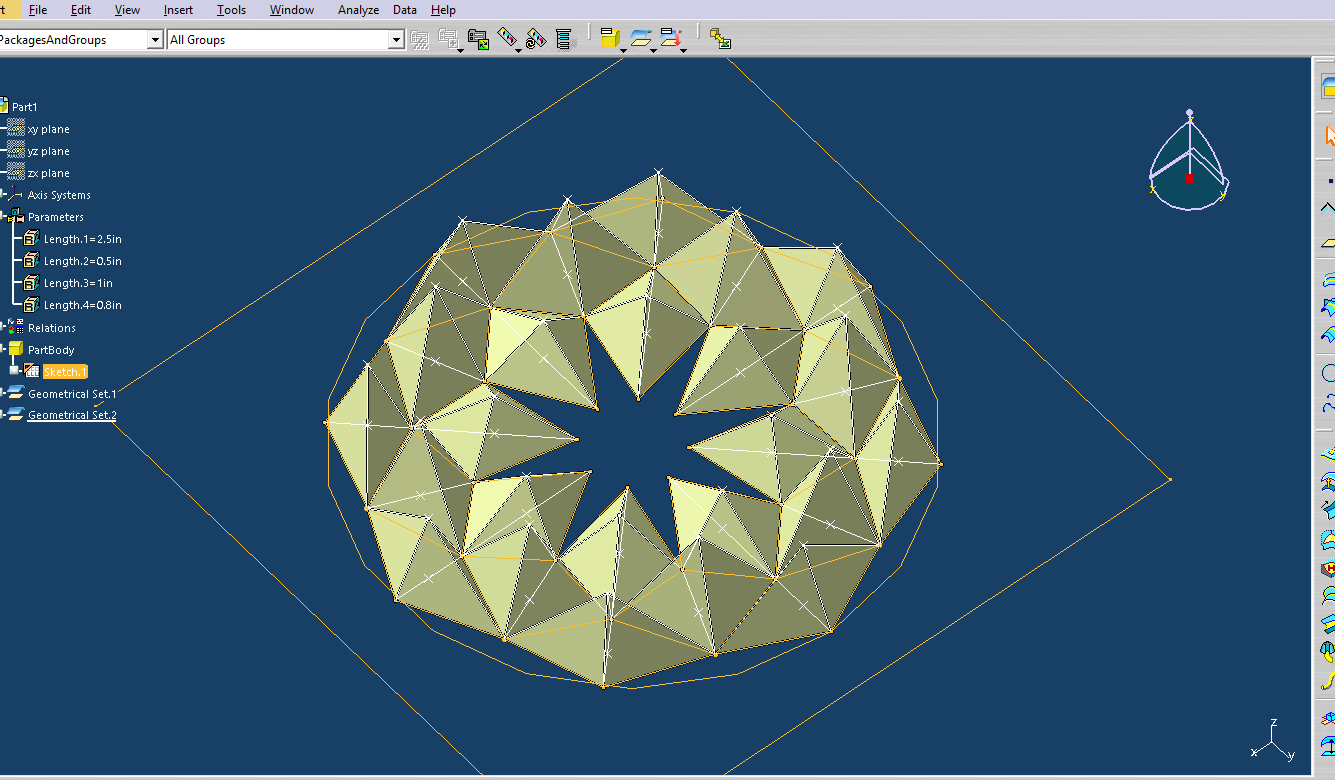Sunday, February 23, 2014
Assign 005 - Framework/STAAD
Here is the analysis done on the members at .01, .1, .2, .3, and .4 % down the original member. I didn't do an animation of the deflection since it isn't noticeable.
Thursday, February 20, 2014
P005 - Loukissass_How do simulations know? response
This reading discusses bridging the gap between speculation, simulation, and built architecture. It discusses the implications of the inaccuracies of simulations, because of their simplification and inability to account for unpredictable variables.
As simulations become more trustworthy, we can challenge the traditional basis of design knowledge. CATIA is one of these tools where many different kinds of knowledge meet, including information from consultants, architects, and fabricators.
Even once simulations have passed all the tests, it is difficult for them to have precedence over trusted regulations. This is not only because of the variables that bring change into an environment but also that varying assumptions can produce virtually infinite results. What use are these simulations to us now? Designing with multiple simulations that attack a problem from different angles is a good way to gain a holistic perspective on building performance. As long as we understand that simulations do not give us a whole or accurate picture of what will actually happen, they do provide valuable information to influence architect's design decisions.
As simulations become more trustworthy, we can challenge the traditional basis of design knowledge. CATIA is one of these tools where many different kinds of knowledge meet, including information from consultants, architects, and fabricators.
Even once simulations have passed all the tests, it is difficult for them to have precedence over trusted regulations. This is not only because of the variables that bring change into an environment but also that varying assumptions can produce virtually infinite results. What use are these simulations to us now? Designing with multiple simulations that attack a problem from different angles is a good way to gain a holistic perspective on building performance. As long as we understand that simulations do not give us a whole or accurate picture of what will actually happen, they do provide valuable information to influence architect's design decisions.
Sunday, February 16, 2014
Assign 004 - Folding paper
So I tried to model this paper fold to make a basic parabola. Based on the tutorial, I was able to get half of it together, but joining them was a bit problematic because it's not planar. I'm not sure how to get this working - maybe make it out of four products to a larger product, instead of two. Also, I'm not sure how to link the dimensions of one part to another - I ended up making 6 individual parts knowing how big they were supposed to be. I'm sure there's an easier way to make a formula for it though...
P 004 - Fabricating Architecture reading response
As parametricism becomes increasingly popular, it is extremely important that architects have a better understanding of fabrication techniques and processes. As the reading points out, a significant number of architects do not, and therefore the accountability and responsibility for construction. Being a CNC router tech myself, it is far easier to design having personal experience and understanding of the limitations of the machine. Unfortunately, we have a lot of students come in who want to make the router do something that it just isn't designed to do. This reading reminded me of this general mentality, and how architects don't actually make anything, they just design. Needless to say, we don't need to all go put our hard hats on and put up framing, but it is increasingly crucial to have a good base understanding of how non-traditional construction methods work, in order to understand budgets and a projects feasibility. With this workflow understanding, we can design more ambitious projects and best understand the advantages of CAD/CAM.
Sunday, February 9, 2014
P 003 - coincident faces and points, changing angles
This week I made three components (re: the tutorial) and associated the faces and center points. The angle was set with a constraint, so that I could change the orientation between components without changing every degree. I had some issues with turning the planes off in the components, because sometimes the whole part would disappear... Resolved eventually with lots of SAVING.
P003 - Architecture of Emergence - Response
The article discusses complex systems, from cities to living forms, to natural forces of evolution. Weinstock presents a new way to think about systems and relationships of parts within a whole. It is the interactions of these parts to their surroundings that produce a coherent form. Examples include schools of fish and flocks of birds, showing the collective behavior of individual organisms result in complex, self-organized forms.
The example of a tree branching was particularly interesting - how it evolved to optimize transportation for fluids, while also maintaining structural stability and maximizing surface area for photosynthesis. The form is not just one thing - but instead a series of parts whose interactions produce a more complex form.
The high level of complexity that is produced from these interactions makes it very difficult to predict the outcome. This relates heavily to our work with Digital Project in that we can make a prediction of the parts final form, but when including multiple relationships, it proves much more difficult. I look forward to exploring what we can produce with digital project, and seeing the unpredictable complexities that develop.
The example of a tree branching was particularly interesting - how it evolved to optimize transportation for fluids, while also maintaining structural stability and maximizing surface area for photosynthesis. The form is not just one thing - but instead a series of parts whose interactions produce a more complex form.
The high level of complexity that is produced from these interactions makes it very difficult to predict the outcome. This relates heavily to our work with Digital Project in that we can make a prediction of the parts final form, but when including multiple relationships, it proves much more difficult. I look forward to exploring what we can produce with digital project, and seeing the unpredictable complexities that develop.
Sunday, February 2, 2014
P002 - Campidoglio
This is campidoglio re-envisioned...
I made the constraints much cleaner, and made everything based on the outside rectangle. The rectangle has two diagonals, making the center point, on which all the circles are based off of. The diagonal construction lines in the circles are based on a pi/8 formula, which is based off the radius of the largest circle. The radius of the smaller circles are all related to the largest as well.
For the solids component, I made the campidoglio into a mountain range/ artichoke.
I built lines between the nodes, placed points on the midpoint, and then made a vertical point based on those midpoints. The polylines connected everything, on which I put a surface. A wise person once told me that triangles are helpful because they don't break:)
All three layers completed: Originally the Z heights were based off of set length parameters for simplicity. Then I played with them changing with the radius of the inner circles of the plan.
Ta da!P002 - Digital Design and Manufacturing response
This reading was a great supplement to how to work and think in Digital Project. From experience of re-modeling project 001 again, it's by far easier to plan the relationship of components ahead instead of determining them as you go, or as an afterthought. Design can't be thought of as solely final form anymore, and designer must focus on the assembly and relationship of components. Digital Design and Manufacturing underlines this importance of breaking down projects into components in software, in order to facilitate the translation into physical construction.
The reading dives into the breakdown of many digital techniques, including surface and volumetric modeling. Turns out that the breakdown of physical manufacturing processes contains this same logic. The final step in digital modeling is the ability to perform specific analysis on components. With programs like Digital Project, we are more able to accurately predict the behavior of designed components digitally, thus informing the process of physical manufacturing.
The reading dives into the breakdown of many digital techniques, including surface and volumetric modeling. Turns out that the breakdown of physical manufacturing processes contains this same logic. The final step in digital modeling is the ability to perform specific analysis on components. With programs like Digital Project, we are more able to accurately predict the behavior of designed components digitally, thus informing the process of physical manufacturing.
Subscribe to:
Posts (Atom)
















